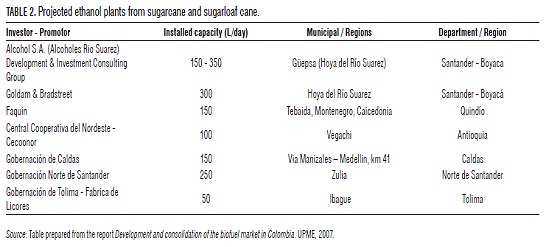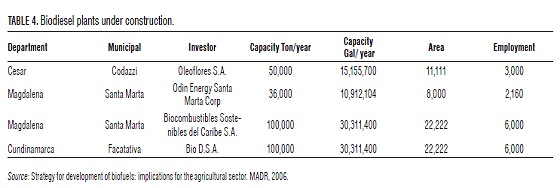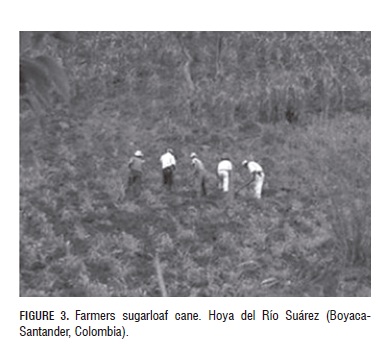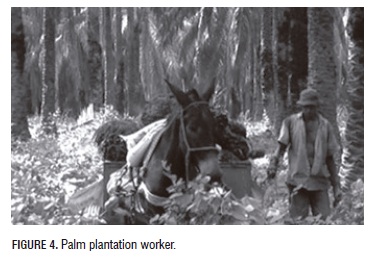Serviços Personalizados
Journal
Artigo
Indicadores
-
 Citado por SciELO
Citado por SciELO -
 Acessos
Acessos
Links relacionados
-
 Citado por Google
Citado por Google -
 Similares em
SciELO
Similares em
SciELO -
 Similares em Google
Similares em Google
Compartilhar
Agronomía Colombiana
versão impressa ISSN 0120-9965
Agron. colomb. v.29 n.1 Bogotá jan./abr. 2011
Agrofuels policy in Colombia: expectations and rural development
Agrofuels policy in Colombia: expectations and rural development
La política de agrocombustibles en Colombia y sus expectativas en el desarrollo rural
Sandra Liliana Mejía A.1
1 Researcher, Environmental Studies Institute, Universidad Nacional de Colombia. Bogotá (Colombia). e-mail: sandramejiaa@gmail.com
2 It was signed on December 11, 1997, in the city of Kyoto and entered into force on February 16, 2005. The Protocol reaffirms the principle of common but differentiated responsibilities and establishes a series of mechanisms that provide flexibility for the parties to fulfill their commitments. This mechanism of "offset" emissions becomes a source of foreign investment and foreign exchange markets with great potential for countries like the American, as Annex I countries can invest in projects to reduce or capture emissions in sectors such as energy, industry, transport, agriculture, waste management and forestry. Kyoto Protocol to the Nations Framework Convention on Climate Change. United Nations, 1998.
Received for publication: 16 June, 2010. Accepted for publication: 2 February, 2011.
ABSTRACT
The debate over the current biofuels policy has two positions: first, those considering it as an alternative aimed at reducing dependence on fossil fuels and contribute to reducing greenhouse gas emissions that contribute to global warming; secondly, those who argue about the distributional conflicts that can bring socio-environmental adoption of these policies at local level. This article presents the national policy settings and scenarios of biofuel production based on agro-energy projects, which are used raw materials such as palm oil to produce biodiesel, sugar cane, sugar loaf cane and cassava for the distillation of ethanol. Thus regional dynamics observed that intersect with the new rural environment in the Colombian countryside connection between the local and global that generate expectations to achieve rural development goals.
Key words: biofuels, agro-energy policy, biodiesel, ethanol, rural development.
RESUMEN
El debate en torno a la política de agrocombustibles parte de dos posiciones: en primer lugar, quienes la consideran como una alternativa orientada a disminuir la dependencia de los combustibles fósiles y a aportar en la reducción de emisiones de gases efecto invernadero que contribuyen al calentamiento global; en segundo lugar, quienes discuten sobre los conflictos socio-ecológicos distributivos que puede traer la adopción de estas políticas a nivel local. En este artículo se presenta la configuración de la política nacional de agrocombustibles y sus escenarios productivos tomando como base los proyectos agroenergéticos en los que se emplean materias primas como palma de aceite para la producción de biodiesel, caña de azúcar, caña panelera y yuca para la destilación de etanol. De esta manera se observan dinámicas regionales que se entrecruzan con las nuevas ruralidades del campo colombiano en su conexión entre lo local y lo global, las cuales generan expectativas para alcanzar metas de desarrollo rural.
Palabras clave: biocombustibles, política agroenergética, biodiesel, etanol, desarrollo rural.
Introduction
One of the alternatives raised in the global energy agenda to overcome the dependence on fossil fuels, is to replace or supplement from the production of fuels from agricultural raw materials directly called agrifuels. This circumstance has given way to a nascent global biofuel market with the production of ethanol and biodiesel. The production of ethanol or fuel ethanol derived from crops rich in starch and sugar as cane, corn, beets, wheat, barley, cassava, among others, on the other hand, biodiesel is obtained from various types of species such as palm oil, rapeseed, sunflower and soybean.
The production of ethanol and biodiesel blends require set levels, needs a large-scale agricultural production, which means expanding cultivated areas of so-called energy crops to supply the needed supply in the process of conversion of fuel conventional ones. Thus, the countries concerned to establish the mixing system must have the growing conditions and availability of suitable land to develop these crops or find the required supply of raw materials for biofuels in other territories and meet the demand for its park automotive.
Latin American countries with export-oriented tradition of some of these raw materials have seen in the emerging market opportunity to boost agro-energy and diversify their economies primary (Pistonesi, 2008). Consequently, their governments have initiated a policy to promote the production, marketing and consumption of biofuels, raising economic benefits and promoting the benefits that these countries can receive advance projects "sustainable" or environmentally friendly to reduce the share of greenhouse gas emissions of industrialized countries, taking advantage of the mechanisms established under the Kyoto Protocol2 countries called "in developing".
Setting up a national agro-energy policy
The promotion of agrofuel production in Colombia is justified by the national government as beneficial to the country in pursuit of national energy independence, rural development expressed in boosting agricultural production and productive employment. Additionally argues that this new leadership is important for the international order to combat climate change, adopted by the country in its accession to the Kyoto Protocol3.
Consistent with the regional trend of South America, has adopted a regulatory framework aimed at the promotion, marketing and consumption of biofuels: first, it encourages the cultivation of raw materials with the expansion of energy crops, and second, it stimulates the production and marketing of biofuels through tax and financial incentives, and third, regulating domestic consumption of ethanol and biodiesel to the establishment of mixing ratios on E-10 (10% ethanol and 90% conventional gasoline) for cities with more than 5,000 inhabitants and B-5 (5% biodiesel and 95% diesel fuel) across the country. In this way regulates a domestic market that ensures domestic consumption increases in the percentages of mixed and permanent over time.
There is talk of setting up a national agro-energy policy, because in reality biofuels are part of a list of prioritized as promising export products that require a package of specific measures to ensure their continued access to international markets and achieve goals in terms of area planted, production and yields. Bet enrolled in agricultural exports from the Ministry of Agriculture and Rural Development 2006- 2020 (MARD, 2006), arranged by the national government and the agro-industrial country.
Among the products prioritized by the government are the traditional exportable coffee, flowers and bananas; late yield crops like oil palm, rubber and forest and are included as export promising "biofuels: ethanol from sugar cane, cassava and sugarloaf cane and biodiesel from palm oil". For the MADR "continued access to foreign markets is necessary for agricultural development because it allows having enough demand to absorb the increasing production and induces specialization in those products that provide higher incomes to the country". The orientation towards specialization of agricultural production for the international market has been a constant of the agricultural policies of Latin American countries that promotes the creation of new production expectations for large, medium and small agribusiness in new settings.
Agribusiness scenario configuration
The National Federation of Biofuels - Fedebiocombustibles, grouped those producers that establishes the core agribusiness, and aims to assist the national government and local authorities in implementing regulations to achieve the expected levels of production. In this sense it begins to set up a regional map in terms of agricultural production centers geared to the production of energy crops for the distillation of ethanol and biodiesel.
Agroindustrial complex of the domestic production of ethanol
Fig. 1 shows the regionalization of the country on production of raw materials for ethanol. There he observed the participation of the traditional region of Valle del Cauca sugarcane include sugarcane regions such as Antioquia, Santander, Boyacá, Quindio, Tolima and appears a new region as the Meta. Cassava cultivation involves the departments of the Caribbean as Bolivar, Cordoba and Sucre, and includes the Orinoco with the Meta. Do not include cultivation of beet for ethanol production, designed for the department of Boyaca.
In October 2005, began production of the first two fuel alcohol distilleries in the country, located in the mills Incauca and Providencia. These two breweries supplied the southwest of the country, specifically the departments of Valle, Cauca, Nariño, Risaralda, Caldas and Quindio, until February 2006, when he entered Bogota oxygenation program and began to operate the mills distilleries Risaralda, Mayaguez and Manuelita, in mid-2007 the supply was extended to the departments of Santander, Norte de Santander, Boyaca and Cesar partially.
The distillation process of ethanol in Colombia is in charge of these five sugar mills, the potential of the region of Cauca river valley is limited, with the production of sugar cane. Distilling plants are supplied with 3.8 million tons of sugarcane, or 16% of production in the country with an area under cultivation for ethanol production estimated at about 35,300 hectares. The industrial complex has a capacity to produce 340,200,000 liters / year, and a planted area of 37,732 hectares. Which, according to the MADR, generate 6962 direct jobs.
Agro-industrial projects to expand production of ethanol
The guild sugar cane producer is aware that increasing domestic demand and the extent to consolidate the business of international biofuels, the potential of the region of the Cauca river valley is limited both by the important need to maintain sugar production to supply the domestic market and the limited availability of land. Therefore, to expand ethanol production in the country and develop a biofuel export industry, you need to design new production centers both sugar cane as the traditional sugarcane. This new geography of sugarcane for energy industry provides for the inclusion of other regions as producers of sugar cane agribusiness and the Meta, Bolívar, Cesar, Sucre and Tolima which they take ethanol plants projected private investment and transnational capital. These projects will open prospects for small and medium producers in these regions and rural employment generation such projects propose to create (Tab. 1).
Tab. 2 shows the projected plants for the production of ethanol from sugarcane and sugarloaf cane. It shows the projection of eight plants that include the participation of the rural economy (Bejarano, 1998) in five regions traditionally producing "panela" (sugarloaf) as Hoya del Río Suarez, Norte de Santander, Quindio, Antioquia, Caldas and Tolima.
The use of cassava as a feedstock for ethanol production produces high expectations in the departments of Cesar, Córdoba, Sucre and Meta. Tab. 3 shows the projection of three ethanol distilleries with public investment, private and transnational levels, which are intended to include traditional small farmers and generate employment in agriculture in these regions.
Beetroot is another crop that takes force within the projects for ethanol. This project began with a 47 fanegadas plantation in the municipality of Tuta, department of Boyaca. The inauguration of the construction of the plant was conducted in late November 2007 and is projected to distill 300,000 liters of fuel alcohol per day. This project has generated great expectations in the region to become a new core agro-energy production that will generate 6 000 direct and indirect jobs. Is projected with a strong transnational capital investment, estimated at 270 million dollars and made by the company ED & F Man, United Kingdom. Putschi German multinational companies with Bma Group and the Swedish Engineering Chematur provide equipment and technology to install automated production system, which includes a reduction of stillage4. Operation was expected in mid 2009 and if the model is successful, its implementation will be screened four departments of Cundinamarca, Cesar, Magdalena and Guajira (Ochoa, 2007).
Agribusiness scenario for biodiesel production
Within MARD estimates, the raw material with higher yield for the production of palm biodiesel is with 5,550 liters per ha per year. The country's agro-climatic conditions allow the production of this crop has had a rapid ascent and has established a guild with high expectations agroindustrial inclusion in the market for biofuels. Fig. 2 shows the distribution of palm oil in the national territory proposed to be used as feedstock for biodiesel production. Identifies four strategic areas to supply domestic and foreign market for palm oil and priority departments in which the crop is expected to expand.
The commercialization of biodiesel in Colombia began January 1, 2008 with a mixture of 5% biodiesel and 95% diesel fuel. So far only one plant covers the production of biodiesel nationwide, Oleoflores SA, located in the Cesar department and supplied with raw material from the north of the country.
According Fedepalma export production projected for 2007 of 250,000 tonnes of palm oil reaches loosely to meet local demand for biodiesel in the mixture of 5%, and there would still be a volume to sell abroad. The union claims that palm acreage and production that now it will be obtained at the end of this decade, it will be possible to meet a percentage of higher biodiesel blend without affecting the traditional market (Fedepalma, 2007).
To achieve these goals the palm guild has the support of the national government, which gives the necessary conditions for the expansion of cultivation to a minimum of 422,000 hectares by 2010, as outlined in the 2007-3477 Conpes. As for potential areas of expansion of plantations, according to a study by the UPME, potential land use for the development of the cultivation of oil palm in Colombia, it is estimated a potential area of 140,274 hectares, which is 82% in ten departments: Meta, Casanare, Magdalena, Cesar, Antioquia, Bolívar, Córdoba, Santander, La Guajira and Norte de Santander (UPME, 2007).
Agro-industrial projects to expand production of biodiesel
To meet the biodiesel market are under construction five production plants with an installed capacity will amount to 315,000 tons per year of biodiesel made from palm oil. Also found in feasibility stage four plants whose capacity would amount to 400,000 tons / year extra. However, it is observed that the production of biodiesel is not yet comparable with the rates of ethanol production provided by the sugar mills.
Tab. 4 shows the biodiesel plants under construction, which are located in the departments of Cesar, Magdalena, and Cundinamarca. Three of these projects are located in the northern palm production, and there is a project for the Andean region will be supplied with raw material from the eastern plains, mainly Meta and Casanare.
Tab. 5 presents the feasibility of biodiesel plants built in the departments of Meta, Santander and Nariño. To the East are identified two projects, one of which belongs to the group Oils Manuelita SA, the same agro-industrial sugar cane for ethanol. For the central region is the partnership between Ecopetrol and seven palm oil companies in the Middle Magdalena5, which make up society Ecodiesel Colombia SA with a screening of building a plant in Barrancabermeja to produce 100 thousand tons of biodiesel (Ecopetrol, 2007). To the West, it is located a project of great interest as Tumaco initiative by the national government.
Local-regional stage: prospects for rural development
The expectations raised in the regional scenario for the production of biofuels attracted to large, medium and small producers, who saw an open market to meet the demands of national, regional and global levels, from a sort of "incommensurability" the market where everyone would have a significant interest. However, statements issued by the government and the unions themselves contrast with the local reality.
So far, agricultural production and processing to the market for biofuels in Colombia is concentrated in two agro-industrial complex. Ethanol demand is supplied by five sugar mills, located in the Cauca river valley, and the production of biodiesel in the agroindustrial complex oil palm Hacienda las Flores, located in the municipality of Codazzi, Cesar. These large producers have benefited from the policy of promoting the production, marketing and consumption of biofuels. No increased risks to your investment, this agribusiness have told a legislative framework that allows comparative advantage in setting up zones that reduce the costs of technology transfer for the assembly of their plants exemptions from income tax, and ensure a permanent and growing domestic market in time, with high expectations for export.
The encouragement of agro-energy production raised expectations of the international market for rural development with the expansion of agricultural production, employment generation and participation of large, medium and small producers (Fig. 3). However, the distribution of the benefits offered by the national agro-energy policy does not meet on equal terms to those who produce the raw material for biofuels that those who produce ethanol and biodiesel.
This is explained, first, because the market generated expectations agroenergy transnational investment with investment in refining facilities for ethanol and biodiesel, in association with the medium producer of commodities such as sugarcane, beet and cassava, without. However, these projects have not yet been finalized and have been in studies of the performance of raw materials, so you have created false expectations for small producers to venture into the agro-energy business as evidenced by the case of Sucre, Cesar with cassava and the case of the Hoya del Río Suárez in the departments of Santander and Boyaca.
Second, the benefits you can get the small farmers with the market lies in the agrofuel expansion in demand for these commodities, however, within the guiding framework for agro-energy policy there is no additional benefit to this type of producers. In recurrent cases analyzed is the position of small producers, stating that such benefits are not reflected in the price of raw materials, there are clear differences in the market. In the case of system partnerships, in which small producers are associated with a great producer, this distribution of benefits can be relativized. For example, the growing conditions are crucial to the success or failure of such agreements, the provision of infrastructure for irrigation and agricultural input costs can be limiting and excluding the distribution of profits in the commodities market for biodiesel. When these small producers do not have conditions that ensure production, end up not being credit recipients or beneficiaries of the Agricultural Income Insurance Program, as observed in the case of Asopalchí in Cesar (Fig. 4). In the case of Tumaco, small farmers have seen their palm plantations affected by the illness of heart rot, and therefore have been forced to create contingency plans renewal of crops and opt for diversified systems such as 70 / 30.
Associated Work Cooperatives - CTA, promoted by Act 50 of 1990, are the joints of the rural workforce. In the case of Valle del Cauca wits, cutters shaped the work stoppages in the work denouncing the disadvantages of this system of piece contracting (Alvarez, 2007). In the case of the palm in the region of Meta, recruitment as the CTA has been exclusive to the local workforce, because it has privileged foreign, in Tumaco, the recruitment system of rural labor has worked according to historical contingencies, the same evolution of the industry palm and conditions of high or low productivity.
The provision of manpower for the new kernels projected ethanol production from sugarcane, involves a floating population of people who have been involved or are victims of armed conflict in Colombia. Thus, in the departments of Bolivar and Sucre projects include plans for employment for demobilized rebels from paramilitary groups, coordinated by the United States Agency for International Development - USAID, in the case of the ethanol project Meta Ecopetrol coordinated by Carimagua involves people displaced by violence.
Fourth, the dynamics of promoting the production of biofuels set of power relations and resistance inscribed within the new rurality. Thus, traditional cultures such as farmers or organic farmers, indigenous communities and afrodescendendientes include in their social and ecological discourse denouncing new forms of appropriation of nature (Perez, 2008). This does not mean the abandonment of old deeds and struggles for land and respect for autonomy over their territories. As observed in the case of the Cauca river valley where, around the production of ethanol, there have been claims socio-ecological-distributional by the Coordination Campesina del Valle del Cauca - CCVC (2008), which are expressed in terms of identity, territoriality and sustainability processes that question the productive forms of appropriation of nature by the agro-industry sugarcane. In this historical process claim ownership of the land that causes the displacement of indigenous communities, rural and peripheral regions black, lack of autonomy in decisions about their territory, pressure on their traditional production methods and low conditions agro-industrial model.
__________
3This protocol is part of Colombian legislation under Act 629 of 2000.
4President Uribe and Queen of Sweden laid the foundation stone of fuel alcohol in Boyacá. Press released by Secretary of the Presidency of the Republic. November 5, 2007.
5The seven companies are: Central SA Extraction, Oil Palm Bucarelia, Extraction Monterrey, Oilseeds Las Brisas, Puerto Wilches Palm, Palmas del Cesar and Agroince Ltd.
Literature cited
Alvarez, R.P. 2007.Los agrocombustibles en boga: el caso del etanol en Colombia. Grupo Semillas, http://www.semillas.org.co consulted:June, 2008. [ Links ]
Bejarano, J. 1998. Economía de la agricultura. Universidad Nacional. Facultad de Ciencias Económicas. IICA-FONADE, Tercer Mundo. Bogotá. [ Links ]
CCVC. 2008. Agrocombustibles la tragedia del campesinado. Coordinación Campesina del Valle del Cauca. Ponencia presentada a la sesión del Senado de la República. Pradera, Valle del Cauca, Colombia. Junio 14 de 2008. http://colombia.indymedia.org/ news/2008/06/88877.php; consulted: August, 2008. [ Links ]
Ecopetrol. 2007. Alianza entre Ecopetrol y palmicultores para producir biodiesel. Vanguardia Liberal, Bucaramanga, 19 de abril de 2007. [ Links ]
Fedepalma. 2007. Balance económico del sector palmero en Colombia - 2007. Fedepalma. http://www.fedepalma.org/ documen/2008/informe_labores_Fedepalma.pdf; consulted: April, 2008. [ Links ]
MADR, 2006a. Apuesta Exportadora Agropecuaria del Ministerio de Agricultura y Desarrollo Rural 2006 - 2020. http://www. minagricultura.gov.co; consulted:June, 2008. [ Links ]
MADR, 2006b. Estrategia de desarrollo de biocombustibles: implicaciones para el sector agropecuario. Misterio de Agricultura y Desarrollo Rural. República de Colombia. http://www. minagricultura.gov.co/archivos/biocombustibles.pdf ; consulted: May, 2008. [ Links ]
MADR, 2007. Los biocombustibles en Colombia. Ministro de Agricultura y Desarrollo Rural. Santa Marta. República de Colombia. http://www.minagricultura.gov.co/archivos/biocombustibles_ septiembre.pdf ; consulted: May, 2008. [ Links ]
Ochoa, O. 2007. Primera planta de alcohol carburante con remolacha. In: Innovación y Desarrollo Empresarial. Colciencias, Bogotá. [ Links ]
Perez, M. 2008. Los agrocombustibles: ¿Sólo canto de sirenas? In: H. Vélez and I. Vélez. Agrocombustibles: llenando tanques, vaciando territorios. Censat Agua Viva - Amigos de la Tierra Colombia. Proceso de Comunidades Negras. Bogotá. [ Links ]
Pistonesi, H., G. Nadal, V. Bravo, and D. Bouille. 2008. Aporte de los biocombustibles a la sustentabilidad del desarrollo en América Latina y el Caribe: elementos para la formulación de políticas públicas. Comisión Económica para América Latina y el Caribe - CEPAL. Santiago de Chile. [ Links ]
UPME. 2007. Desarrollo y Consolidación del Mercado de Biocombustibles en Colombia. Unidad de Planeación Minero Energética. Ministerio de Minas y Energía. Biofules Consulting. Bogotá. [ Links ]























